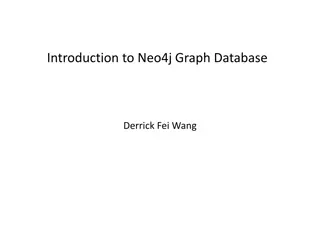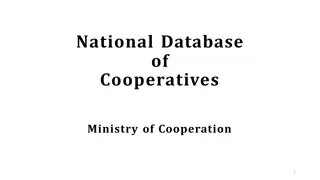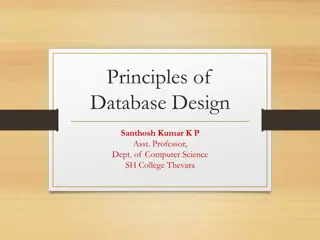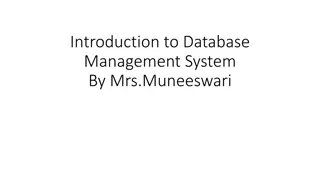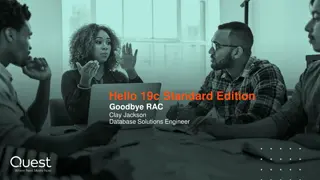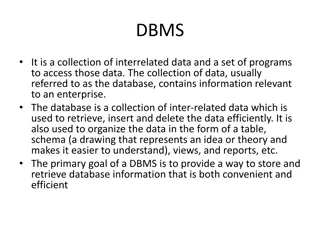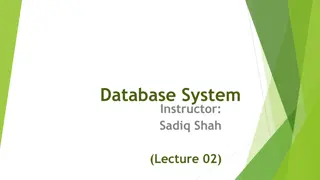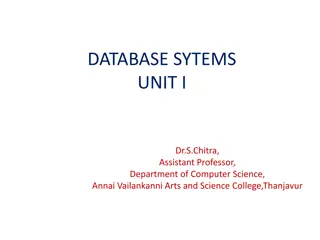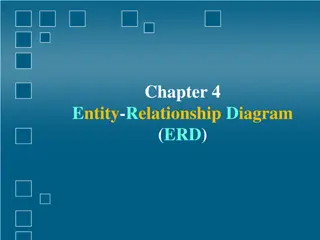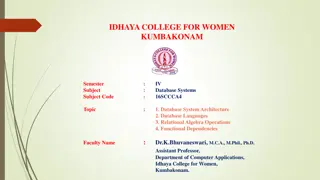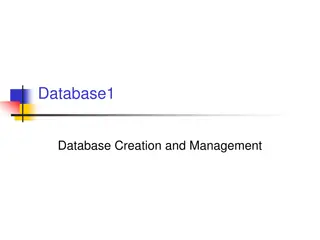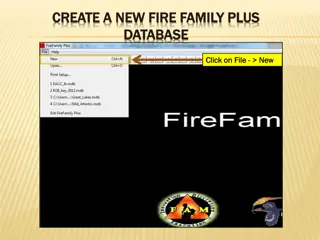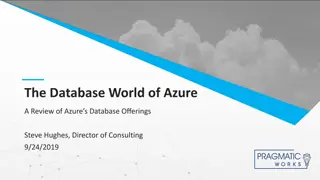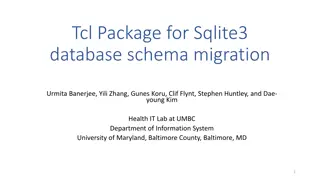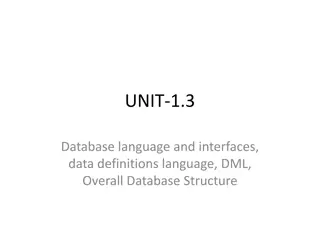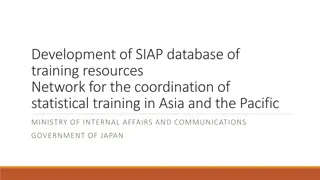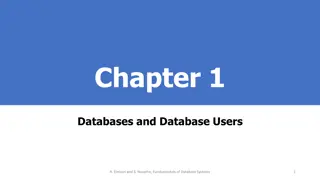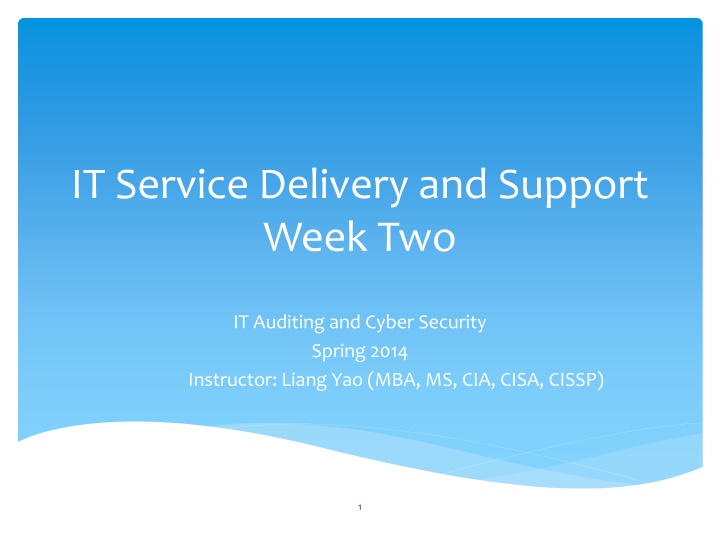
IT Auditing, Cyber Security, and Database Fundamentals for Spring 2014
Explore IT service delivery, infrastructure essentials, computer hardware, operating systems, system software, and database concepts with a focus on auditing, cyber security, and IT fundamentals in the Spring 2014 session. Learn about the importance of hardware components, operating system controls, system software functions, and database management in ensuring secure and efficient IT operations.
Download Presentation

Please find below an Image/Link to download the presentation.
The content on the website is provided AS IS for your information and personal use only. It may not be sold, licensed, or shared on other websites without obtaining consent from the author. If you encounter any issues during the download, it is possible that the publisher has removed the file from their server.
You are allowed to download the files provided on this website for personal or commercial use, subject to the condition that they are used lawfully. All files are the property of their respective owners.
The content on the website is provided AS IS for your information and personal use only. It may not be sold, licensed, or shared on other websites without obtaining consent from the author.
E N D
Presentation Transcript
IT Service Delivery and Support Week Two IT Auditing and Cyber Security Spring 2014 Instructor: Liang Yao (MBA, MS, CIA, CISA, CISSP) 1
Infrastructure Essentials Computer Hardware Operating Systems (OS) & System Software Applications How Applications, System Software, and Operating System Programs interact Distributed Systems vs. Legacy Systems Production Environment vs. Development and Testing Environments General Control and Application Reviews 2
Computer Hardware Definition: All physical mediums to record, retrieve, store, process, input, output, and transmit digital and analog signals/information. - CPU - Hard drive - Memory - Mother Board - Video Card/Sound Card/Camera - Network Interface Card - CD ROM/USB/PS2 Connector - Mobile Devices 3
Operating Systems (OS) OS Built-in Controls: authentication and authorization, scheduler, traffic controller, planner, and security to resources of a computer system and/or its network (wired or wireless). Microsoft Windows UNIX/Linux Novell Netware, AS/400 & Mainframe Some OS work with third party security software: Mainframe TOP Secret, ACF2,RACF 4
System Software System Software: software used by System users (such as Database Administrator (DBA) System Administrator (SA) to support the running of OS Database Management Systems, SQL, Network Client, OnLine Transaction Processors (OLTP), etc. System Utilities such as FTP, Telnet, SNA and Shell Scripts 5
Database Types of Databases Flat-file Hierarchical Data base Network Database Relational Database Benefits of Database versus Traditional file organization Audit Concerns in a Database Environment IT Audit Fundamentals 6 3/21/2025
Database vs. Flat files Benefits Flexible Analysis: Perhaps the raison d' tre of databases -- they are capable of sophisticated, complex, relationally-oriented searches and queries. You can really slice & dice your data in far more intricate ways than with Excel. Scalability: Once you move into the realm of gigabytes of data, text files really start to stretch at the seams. Databases can be much more efficient and resilient at this scale. Availability & Consistency: If you have multiple users collaborating on the same data, a DB can ensure that everyone is looking at the same version and can help prevent people from overwriting each other's flags. 7
Database vs. Flat files Drawbacks Disruption: How many users are going to use this new system? How invested are they in the current system? How many other applications need to interact with the data? Learning Curve: A DBMS can be a real bottleneck to those who aren't familiar with them. Who is going to train the users? Will their beloved data now be virtually "locked up" behind some DBA's desk? They will have to learn to read & write SQL, and how to interact with the MySQL interface, unless you plan to create a sophisticated front-end application for them (a daunting task!) Tech Support. Who is going to manage the DBMS software and servers (upgrades, patches, outages, etc.)? You've already indicated that IT is reluctant. Are you prepared to manage this yourself? Cost. Even though MySQL is free, there are other conversion costs to consider, particularly migration time. Is management prepared to support a several-month gap in production time? 8
Audit Concerns in a Program-Centric Environment The risk of many programs written for many departments by programmers all working against the same information - or copies of the files - is that there is no single program that has control over the format and integrity of the data. If any of these programs is written incorrectly, there is a risk that the program can corrupt the data. 9
Audit Concerns in a Program-Centric Environment Major Risks Copies of the same databases are not synchronized Copies of the same databases do not have identical security controls. Application programs working against the same copy of the database do not have identical controls protecting the data read from and stored in the database. 10
Data-Centric Model In a database environment, application programming uses Structured Query Language (SQL) or the native programming language of the database management system (DB2/Oracle, Sybase, etc.) to read and write data. 11
Data-Stand alone Model Programs and its database are resided in an standalone environment. Dedicated server (PC, workstation) for a specific application. Virtualization and Cloud Computing. 12
Database Terminology A database is collection of data elements that can be organized to meet requirements of a universe of user applications. The logical view(s) is how a particular program views the data. The physical view is how the data is actually stored. 13
Database Terminology (continued) Database Management System (DBMS) A DBMS manages data by providing organization, access and control functions; includes a variety of management and security features, depending on the particular DBMS. Older versions are hierarchical, in that there is a specific and somewhat rigid "parent and child" relationship among data elements; newer versions are relational, allowing dynamic reformatting of the tables that drive data access, so that they are more flexible and adaptable to changing needs. 14
Database Terminology (continued) Data Dictionary/ Directory System (DD/DS) Software that manages a repository of information about data and the database environment, allowing applications to share data elements and each application to have its own view of that data 15
Database Terminology (continued) A view is a logical grouping or set of data displayed as needed to meet a request by a user or an application. In a view, combined files can be displayed, printed or queried; fields to be included are specified by the user. The files themselves are not linked beyond that view, but if the system allows editing, data can be changed. A logical view can be set up for an application program so that only the needed set of data needed is available to the program. Security controls can allow read or read-write access to specific data elements. One data element can be used by many programs. 16
Database Terminology (continued) Database Administration (DBA) control of data related activities, the DBA can be one or more people, depending on how large the environment is. Data is organized into tables, columns and rows. A table is equivalent to a file, as it represents a collection of records. A row is a horizontal set of data fields or components. A column is a vertical set of data fields or components (think of a spreadsheet's rows and columns for a comparison). A function involved in the coordination and 17
Database Terminology (continued) Database Management System (DBMS) Database management systems have features to help ensure the integrity and security of data stored in the DBMS tables. These include: Rules Triggers A Stored Procedure Security 18
Rules Rules define format and range of data that can be stored. For example, a rule can stipulate that a "loan interest" field cannot hold a negative number, or that allowable rates will be within a range of 6-12%. 19
Triggers Triggers can activate a DBMS stored procedure when a field, record or table is inserted, updated or deleted. For example, a trigger can cause an email to be sent to the security administrator when a record in the USER ID table is 20
Stored Procedure A stored procedure is a program written in the native language of the DBMS. Stored procedures behave like any other program, although native DBMS has additional verbs for database actions unique to the DBMS environment. Examples include SORT, LOCK, UNLOCK and COMMIT. 21
Security Security features - the DBMS provides ability to allow or deny a user or group access to a database, table, record or field. Some systems can also allow or deny a user or group administration ability. Additional security features including data encryption and scrambling. 22
Types of Databases A database management system (DBMS) manages data by providing organization, access, control and security functions. There are four classes of database structures. They are listed in the order of their evolutionary appearance: Flat File Hierarchical Networked Relational 23
Flat File Flat-File A flat-file stores records without any relationships what so ever. Records can be stored in any arbitrary sequence, or in the order they were created. There can be one or more indices to optimize searching for records. 24
Hierarchical Database A hierarchical database stores records in a hierarchical order such as last name, customer number, or part number. Every record contains the record data and pointers to the child records. Some hierarchical databases also store pointers to the parent records. Records are placed into the database in the order they appear in the physical word. 25
Hierarchical Database All searches begin at the top of the database. Following pointers down (or up) take you from record-to-record in their sorted order. If a new record needs to be inserted into the structure, the position of the record on the disk does not change; only the pointers need to be updated. A hierarchical database can have only one top (or root) record. 26
Network Database A network database is similar in construction to a hierarchical database except there can be more than one root record. 27
Relational Data Base A relational database is a collection of data items organized as a set of formally described tables from which data can be accessed easily. A relational database is created using the relational model. The software used in a relational database is called a relational database management system (RDBMS). Relational term SQL equivalent relation, base relvar table derived relvar view, query result, result set tuple row attribute column 28
Examples of relational databases Examples of relational databases include: DB2 Informix Lotus Approach MS Access Oracle SQL Server Sybase 29
Benefits of Database versus Traditional File Organization Functions Relational databases offer a wide array of functions that create advanced data manipulation techniques. They support relational algebra as well as set operations. This includes operations to select, join and divide. Many of these operations are possible only with relational databases. This data manipulation is possible with the use of queries, generally in Structured Query Language (SQL), to manage the data and give users the information they are looking for. 30
Benefits of Database versus Traditional File Organization Efficiency Efficiency is one of the benefits to a relational database. Because of the ways in which data can be compared and combined, each piece of data needs to be saved in only one place. This is related to the process of normalizing the database, which eliminates the need for duplicate data. Since each piece of data is saved in only one location, it is much easier and quicker to update. The language used to create the database, SQL, can also validate date entry. 31
Benefits of Database versus Traditional File Organization Views Because relational databases are highly customizable, users can present data in any way they wish. One of the most important concepts of the database is known as a view. Although the data is stored in tables, which may never change attributes, users can customize or delete a view easily without affecting the data. Views manipulate the data to present the important pieces that users would like to see, while removing the unnecessary data that is not used. This is similar to copying and pasting the important parts of documents into one file. 32
Benefits of Database versus Traditional File Organization User-Friendly Relational databases store data in tables, which are linked together with key values that give a clear relationship between the tables. The linking of tables by key values makes it easy to diagram those tables so that users can see all relationships. The support for SQL, which is similar to writing statements in English, also makes relational databases user-friendly. As stated in the article "Introduction to SQL" from Devarticles, "SQL statements look like simple English sentences, making SQL easy to learn and understand. This is in part because SQL statements describe the data to be retrieved, rather than specifying how to find the data." 33
Audit Concerns in a Database Environment The database can become the single point of failure. When the database is unavailable, all applications relying on the database will not work. Many applications might be authorized to update the same data fields. How do applications become authorized? What is the synchronization schedule for the databases replicates? Applications working against the database may not have the same security and integrity controls. Distributed copies of the database may not have the same security settings. 34

